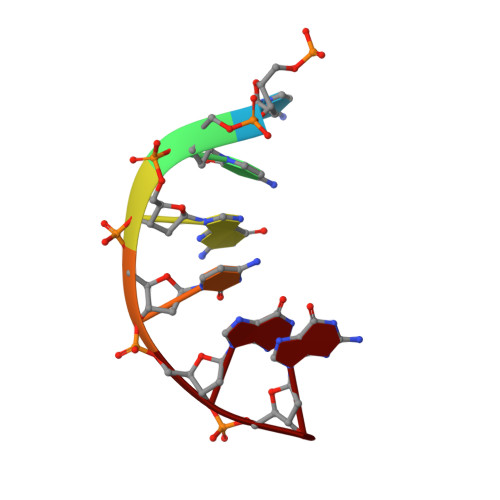NMR study of hexanucleotide d(CCGCGG)(2) containing two triplet repeats of fragile X syndrome.
Monleon, D., Esteve, V., Celda, B.(2003) Biochem Biophys Res Commun 303: 81-90
- PubMed: 12646170
- DOI: https://doi.org/10.1016/s0006-291x(03)00304-8
- Primary Citation of Related Structures:
1N1K - PubMed Abstract:
Long repeated stretches of d(CCG) and tri-nucleotide are crucial mutations that cause hereditary forms of mental retardation (fragile X-syndrome). Moreover, the alternating (CG) di-nucleotide is one of the candidates for Z-DNA conformation. Solution NMR structure of d(CCGCGG)(2) has been solved and is discussed. The determined NMR solution structure is a distorted highly bent B-DNA conformation with increased flexibility in both terminal residues. This conformation differs significantly from the Z-DNA tetramer structure reported for the same hexamer in the crystal state at similar ionic strength by Malinina and co-workers. Crystal structure of d(CCGCGG)(2) at high salt concentration includes a central alternating tetramer in Z-DNA conformation, while the initial cytosine swings out and forms a Watson-Crick base-pair with the terminal guanine of a symmetry-related molecule. In solution, NMR data for sugar ring puckering combined with restrained molecular dynamics simulations starting from a Z-DNA form show that terminal furanose residues could adopt the conformation required for aromatic bases swinging out. Therefore, tetramer formation could be considered possible once the hexanucleotide had previously adopted the Z-DNA form. This work gives some insight into correlations between anomalous crystal structures and their accessibility in the solution state.
Organizational Affiliation:
Departamento de Química Física, Universitat de València, Edifici d'Investigació, Lab 3-054, C/ Dr. Moliner, 50, Burjassot, 46100 Valencia, Spain.














